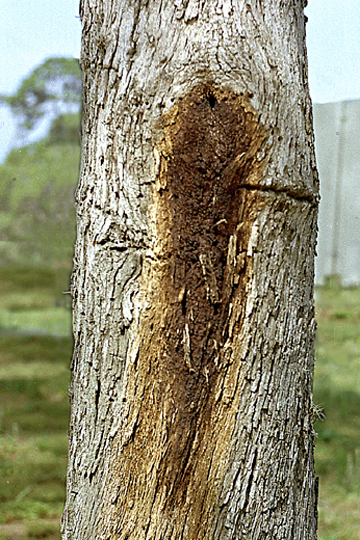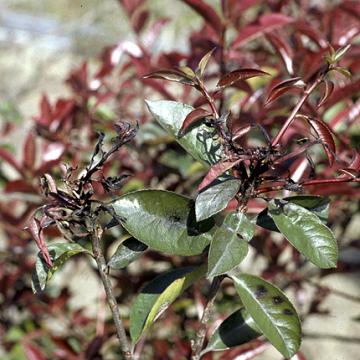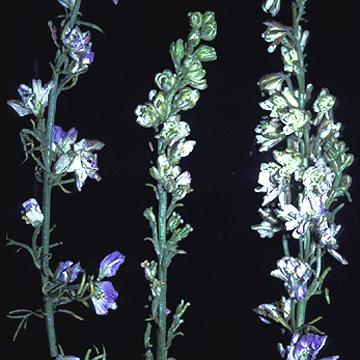DISEASE: Bacterial blight
HOST: Photinia
Symptoms of photinia bud blight shown here are similar to those of blast of pear and apple, caused by Pseudomonas syringae pv. syringae.

Bacterial blight | Photinia
DISEASE: Bacterial blight
HOST: Photinia (Photinia glabra)
PATHOGEN: Pseudomonas syringae pv. photiniae
SOURCE: M. Goto
DISEASE: Bacterial leaf spot
HOST: Larkspur
Infected leaflets with many purplish spots with necrotic centers.

Bacterial leaf spot | Larkspur
DISEASE: Bacterial leaf spot
HOST: Larkspur (Delphinium sp.)
PATHOGEN: Pseudomonas syringae pv. delphinii
SOURCE: R. Raabe
DISEASE: Fire blight
HOST: Photinia
Fire blight cankers on photinia.

Fire blight | Photinia
DISEASE: Fire blight
HOST: Photinia (Photinia fraseri)
PATHOGEN: Erwinia amylovora
SOURCE: M. Schroth
DISEASE: Fire blight
HOST: Photinia
Typical crook neck symptom of infected shoot.

Fire blight | Photinia
DISEASE: Fire blight
HOST: Photinia (Photinia fraseri)
PATHOGEN: Erwinia amylovora
SOURCE: M. Schroth
DISEASE: Larkspur virescence
HOST: Larkspur
Two diseased plants with stunted and small leaves, lack of flower coloration, and bunched flower buds. Healthy plant (left).

Larkspur virescence | Larkspur
DISEASE: Larkspur virescence
HOST: Larkspur (Delphinium sp.)
PATHOGEN: 'Candidatus Phytoplasma asteris'
PATHOGEN SYNONYM: Phytoplasma Aster yellows group
SOURCE: R. Raabe
DISEASE: Slime flux
HOST: Casuarina
Slime flux occurs on a number of tree species and is always associated with bacteria and yeast. However, the causal agent has not been identified.

Slime flux | Casuarina
DISEASE: Slime flux
HOST: Casuarina (Casuarina equisetifolia)
PATHOGEN: Causal agent unknown
SOURCE: W. Sinclair







